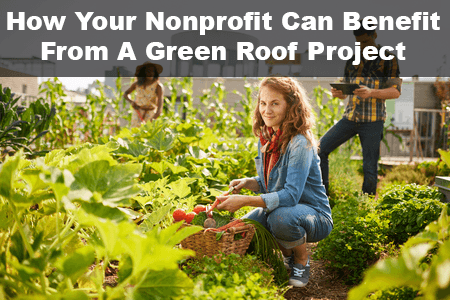Going green and installing an energy saving green roof is a wonderful way to reduce your nonprofit’s costs – and help you raise more funds! It also shows your commitment to help your community by reducing your carbon usage.
Whether you are building an entirely new building, remodeling, or just considering a future investment, here are the basics of what you need to know about a green roof project for your nonprofit.
What is a green roof?
A green roof means that all or part of a building’s roof is covered with vegetation and related soil or means to grow that vegetation. Usually it also is comprised of an extra waterproof layer underneath the vegetation to compensate for continual moisture. Green roofs also include ponds, established when drainage is poor as a natural treatment for graywater.
Vegetation can be thin, only a couple of centimeters, or entire landscapes or vegetable plots. Some count a potted plant garden as well as a green roof.
What are the environmental benefits of a green roof?
- Reduces cooling needs on a building generally between 50-90 percent by absorbing the sun’s energy.
- Reduces heating needs as well by providing extra insulation in the winter.
- Reduces storm water run-off – in places like cities where drainage is poor or storage for drainage is poor, this is especially useful to avoid wastewater pollution runoff into streams and lakes.
- Filters pollutants and CO2 directly out of the air.
- Cools urban areas overall, reducing heat island effect substantially in cities where roofs are clustered together.
- Provides habitat for native bees, birds, and other wildlife.
Also read: Fundraising For A Wind Energy Project
What are the economic benefits of a green roof?
Though extensive roof systems on big buildings can be expensive, a small scale project costs only 10-14 percent more than a traditional roof to install. It not only reduces heating and cooling costs, but a green roof also extends the lifespan of a roof by up to 200 percent. So, for only a bit more inversion, the ROI is huge in both immediate cost savings to heating and cooling and long term valuation in your building overall.
The Government Services Administration (GSA) published that a simple green roof covering 10,000 square feet has a Net Present Value of $2.70 per square foot per year, paying back its installation cost in 6.2 years.
Buildings with fewer floors save even more money. When community benefits are factored into the savings (reduced temperature, air pollution, storm water runoff, and CO2), all levels of green roofing result in benefits outweighing installation and maintenance costs.
How difficult is green roof maintenance?
Depending on the type of roof you choose, your maintenance can be intensive or completely nonexistent. Usually roofs are classified as extensive, semi-intensive, or intensive.
- Extensive: lowest maintenance costs, no irrigation requirements. Comprised usually of simple mosses and grasses to add an eco-layer to an existing building or a less supportive rooftop structure. This Old House has a DIY page on how to put one of these in yourself!
- Semi-intensive: have a deeper soil/substrate layer than extensive rooves, and they require periodical maintenance, including irrigation. You would have to install a special roof system to hold the weight and to factor for the additional moisture, which will be more expensive. It gives you many more plant options, however, including easy vegetables and fruits! Plus your environmental and economic benefits will be greater.
- Intensive: this is a full-scale effort to build an entire landscape, including small trees and ponds, on top of your building. You need up to a full meter of soil or substrate to grow those plants. You will most likely need an irrigation system and designated caretaker as well.
How much does a green roof cost?
Costs start around $15/square foot for a 4 inch system (an extensive system that includes mosses and herbs). Costs can be up to 50 percent higher for semi-intensive systems and are at least twice as much for intensive systems. Plus, if you have a lot of slope on your roof, installation will be higher.
Also read: Be Arty, Be Green, Make Money: How Bottle Cap Murals Can Help Your Nonprofit
Can a green roof help you raise funds for your program?
Yes! There are thousands of direct grants and subsidies in local areas across the country to help with green projects, especially green roofs. Here are some resources that list specific programs:
- DSIRE: Possibly the most comprehensive database for local and state energy incentives.
- My Plant Connection: Green Roof Legislation, Policies, and Tax Incentives.
- EPA’s Green Infrastructure Funding Opportunities.
- VegetalID.: List of green roof incentives across the US.
Plus, there are indirect fundraising benefits. America is not going green; it is green. More than half of Americans will spend more money now just for sustainable products. And ninety percent agree that society needs to become more energy conscious. So not only are you adding a project component that helps you save operating costs down the line, but you are also branding your nonprofit as community conscious and sustainable. That improved brand can be marketed back to your constituency to improve your image – and to improve your donor pool.
In sum, especially if you have to renovate your current roof or build a new building entirely, a green roof is probably worth it. The only challenge is deciding on what scope of a project you want to endure – a simple, moss and herb maintenance free roof, or a full scale garden lounge!

